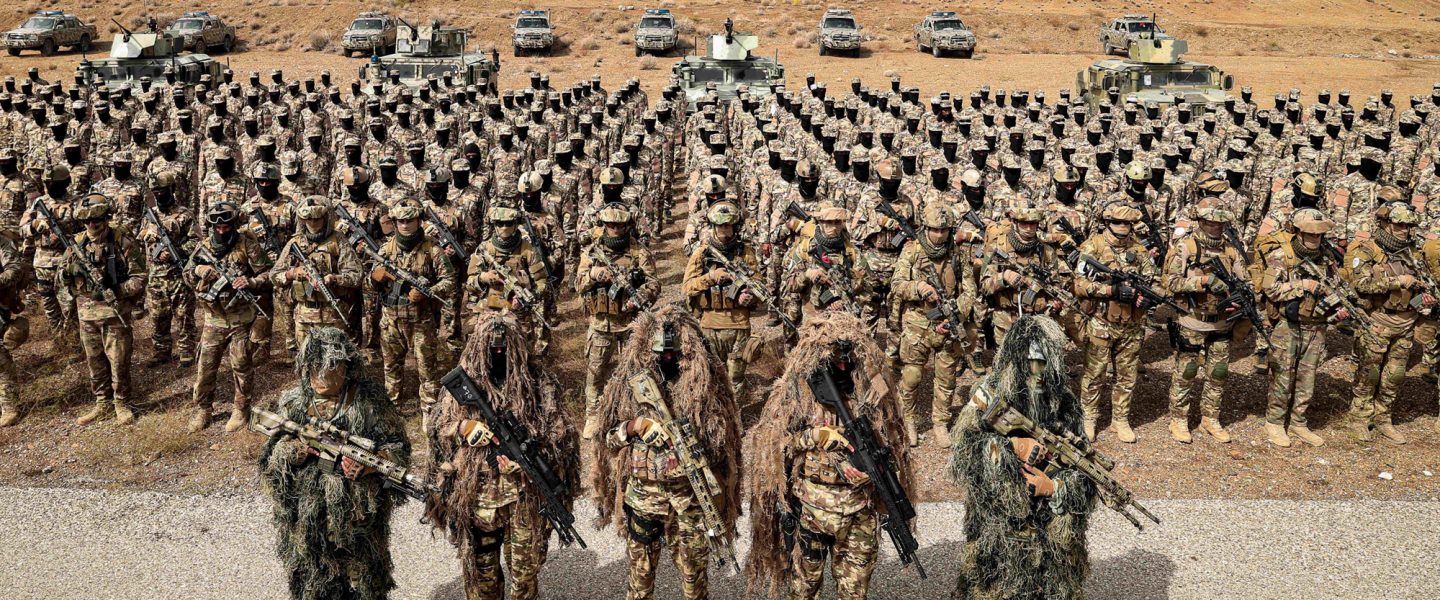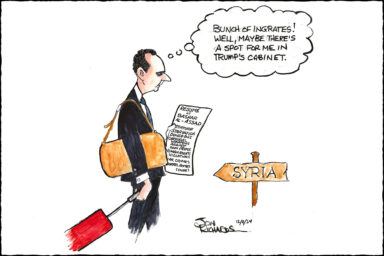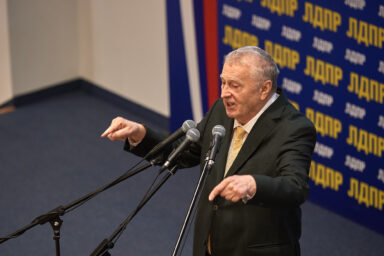While a UN humanitarian chief appears to have made headway in convincing the Taliban to loosen some of their constraints against women, it still looks as if everyone is shooting themselves in the foot when it comes to dealing with Afghanistan.
|
Listen To This Story
|
UPDATE: At a UN press conference in New York on Monday 30 January 2023, UN Emergency Relief Coordinator Martin Griffiths stated that they were hopeful the Taliban would rescind at least some of their constraints, but could not say when or to what extent. “Our job is to identify the opportunities (of persuasion by the international community, local populations and within the Taliban themselves) and to advocate constantly for a fair and just Afghanistan,” he said.
“It’s a brutal situation because none of the key players are willing to back down,” said the representative of an international organization with several decades’ experience in Afghanistan and the region. “You cannot go in and tell the Taliban what to do. They’ll only hunker down even more because they don’t care what outsiders think. And the Americans and Europeans only want to talk about girls’ education and women’s rights, so that’s not going anywhere. The Taliban hardliners did not fight all these years to re-impose an equitable society. That’s the sad reality, but once this is recognized then perhaps the international community can start moving forward.”

As both he and other experienced observers point out, there is no single approach that will convince the Talib leadership to change its policies. The international community may be looking at months, possibly years, to achieve even limited reforms with different initiatives by respected groups and individuals ranging from international NGOs, such as the Norwegian Refugee Council and the Swedish Committee for Afghanistan, to the UN itself.
At some point, too, countries perceived as neutral, such as Switzerland, Norway, Finland, and Iceland, might emerge as possible long-term mediators. When asked to comment, the Swiss Foreign Ministry maintained that while it remains in touch with key actors in Afghanistan and across the diaspora, and is fully prepared to offer its good offices, “any mediation requires a mandate and the consent of the parties to the conflict.” Switzerland has mediated in the past and played a crucial role in talking to all warring groups during the 1979–1989 Soviet occupation of Afghanistan. There is also pressure that International Geneva embrace a more engaged mediation rather than just a messenger role.

How to Get the Mediation Process Moving
“But it may take a respected figure — whoever that be, Afghan or otherwise — to initially open the door,” noted Michael Keating, executive director of the European Institute of Peace (EIP) in Brussels who first became engaged with Afghanistan during the UN’s Operation Salam in the late 1980s leading to the Soviet Red Army withdrawal. “This will mean someone highly knowledgeable regularly visiting or even based in Kabul who is respected by the Taliban. We’re talking about a lot of tea-drinking and patience.”
“You can talk an Afghan into going to hell, but you can’t talk him into going to heaven.” (Afghan proverb)
Some believe that former President Hamid Karzai, a Pashtun from Kandahar, or Abdullah Abdullah, a Tajik-Pashtun from Panjshir and former chief executive during the NATO occupation, could emerge as possible candidates. Others disagree, arguing that neither command sufficient credibility or trust. While the last Western-backed Afghan president, Ashraf Ghani, has proposed himself as a contender, he is widely regarded as corrupt and arrogant with little or no leverage left. As a result, finding a reputable Afghan with standing remains a critical challenge. As one analyst put it, quoting an old Afghan saying: “You can talk an Afghan into going to hell, but you can’t talk him into going to heaven.”

Some, too, including within the international aid and conflict resolution community, believe that the private sector could play a significant role. Peter Jouvenal, a British businessman and former journalist engaged with Afghanistan since 1980, who was arrested and held last year for six months by the Taliban, sees it as capable of nudging the current regime toward greater openness. “If the Taliban are able to see that more open investment is one of the only ways of helping the country back to recovery, then they may agree to re-establishing certain rights,” he said. “But they will only do it on their own terms, not if they’re pressured.”
As for China, India, Turkey, and Qatar, they are all exploring investment possibilities, notably mineral resources with an estimated worth of up to $3 trillion yet remain hesitant as long as the Taliban go against the international flow. “The Chinese are not particularly looking to help resolve the Taliban’s political problems but are quite happy to engage with economic initiatives that can be exploited regardless,” said one international aid source in Kabul referring to Beijing’s efforts to develop the Mes Aynak copper mine, one of the world’s largest with up to 12 million tons of reserves. “We’re looking at significant potential investment initiatives, but these may drag out for years.”

Russia, which previously supported the anti-Taliban resistance leading up to the US-led invasion in October 2001, is believed to be negotiating with the cash-hungry Taliban for the purchase of sophisticated military equipment for deployment in its war in Ukraine. Abandoned by NATO forces during their calamitous withdrawal from Afghanistan in August 2021, much of it, including ammunition, is lying in guarded but often exposed storage locations.
Many majority Muslim countries, such as Indonesia and Malaysia, which had diplomatic relations with Afghanistan in the past, disagree with the Taliban’s backtracking on women’s education and their right to work. As pointed out by one Dubai-based international lawyer, “some openly consider such constraints as un-Islamic and have made this point to the Taliban.” To date, no country recognizes the Taliban regime. and hence there is insufficient lobbying to generate the official representation at the UN that the de facto regime in Kabul seeks. Various Afghan diplomatic missions such as Geneva and Washington are still represented by pre-regime ambassadors, several of whom see themselves as possible players in bringing about rapprochement, although it is unlikely that the Talib hardliners will cooperate with them.
Afghanistan Is Running Out of Time

For Keating, the main objective now is restoring economic activity. “Humanitarian aid is essential but not the answer. And Western development aid is politically impossible,” he adds. “A complete collapse in trade, investment, [and] jobs will deepen the humanitarian crisis, will not resolve the human rights situation, and will make women and children even more vulnerable. Rebooting the banking system and investments to create jobs is fraught with complexity but may increase the chances of the kind of change the international community is seeking.”
According to UN estimates, a staggering 97 percent of Afghans are now living in poverty, while two-thirds require basic humanitarian aid to survive. Out of a population of 40 million people, half face acute hunger. So Afghanistan, which now represents the world’s largest humanitarian operation with 28 million receiving aid, is running out of time.
As Martin Griffiths, head of the UN’s humanitarian operation (OCHA), maintains: “Without women working, we can’t deliver for the people who are in fact the primary objects of humanitarian assistance — women and girls. So it’s a practical matter. It’s beyond rights.” With many years’ experience dealing with the Taliban, Griffiths, who has just completed a dialogue foray to Afghanistan as part of an Inter-Agency Standing Committee (IASC) team, expressed hope that the leadership would be willing to rescind their recent ban on women working with international aid organizations. (For the moment, this does not affect Afghan women employed by the UN).

“I think they’re listening,” Griffiths told the BBC of the Talib ministers he had met. “They told me they will be issuing new guidelines in due course which I hope will help us reinforce the role of women.” At the same time, Griffiths is fully cognizant that any long-term reforms may take a lot of subtle, under-the-radar negotiation to convince the Taliban.
Yet even this may not prove easy. As the Taliban’s head of disaster management, Mohammad Abbas Akhund, a cleric, told the BBC: “Men are already working with us in the rescue efforts and there is no need for women.” He strongly condemned the UN and other aid agencies for not respecting “our religious beliefs,” an allegation denied by Griffiths who said that such beliefs are always respected wherever the UN operates. Akhund further maintained that even if the UN halted its distribution of food to Afghanistan this would not change his government’s position.
For the moment, much of the work undertaken by the United Nations Assistance Mission in Afghanistan (UNAMA) in Kabul is in the form of its own subtle diplomacy. “Maybe 95 percent of what we do is based on quiet discussions with the Taliban, ordinary Afghans and the different NGOs,” said one UNAMA representative. “This is the only way to know what really is going on.”

Nevertheless, the UNAMA regularly helps organize official UN visits, such as the high profile four-day visit by a delegation in mid-January 2023 headed by UN Deputy Secretary-General Amina Mohammed, a British-Nigerian Muslim, to “appraise the situation, engage de facto authorities and underscore UN solidarity with the Afghan people.”
While the largely female delegation, including the director of UN Women, an agency focusing on women’s issues, met with select Talib leaders in Kabul, Kandahar, and Herat, it was not received by any key figures. The most notable, Haibatullah Akhundzada, the fundamentalist Pashtun Islamic scholar, cleric, and jurist considered to be the supreme leader of the Taliban, refused to meet with them. But then, as one international source in Kabul pointed out, “this is not surprising as he does not even meet with some of his own ministers.”
While the UN delegation sought to reach out to Afghan women, as well asNGOs and other organizations, to emphasize the international community’s commitment to female rights, it was criticized for playing to the gallery without contributing toward any real change other than to aggravate the hardliners. While Griffiths’ trip was perceived by some as a “to do” initiative by someone with significant background to Afghanistan, Mohammed’s was referred to as one more “for show.”
A similar largely women’s visit conducted during the first Talib rule in 1997 produced equally limited results. When a delegation headed by the European Union’s Emma Bonino and CNN’s Christiane Amanpour sought to highlight the plight of Afghan women by filming in a Kabul hospital, their highly mediatic presence only managed to anger the new jihadi leadership who ordered the temporary arrest of all 18 members of the group.

“Perhaps I shouldn’t say this as a woman, but many Afghans were shocked by the way she [Amina Mohammed] went about her visit,” said Hassina Syed, an Afghan businesswoman, philanthropist, and politician. Syed, who was evacuated from Kabul in August 2021 to the United Kingdom, remains in close contact with Afghanistan, including the Taliban. “We are all deeply concerned by what is happening and we want to help, but you need to be serious about connecting with the Taliban.”
Syed further stressed that if one is to make headway in bringing about genuine change, then one needs to operate with the right background experience based on a close knowledge of the country. “You need to work with quiet diplomacy and be in Afghanistan full-time. That’s the way Afghans are. It takes a long time to build trust. You can’t just go in there and talk about women’s rights. They’re not going to listen to you.”
Another concern voiced by Afghans and international aid representatives is that some international donors would like nothing better than to disengage from Afghanistan. This is primarily for budgetary reasons but also because of other more immediate distractions such as Ukraine. As some donors have already noted, the international community fought a pointless war and spent billions of dollars trying to support Afghanistan’s long-term recovery to no avail, except, as some maintain, its ability — largely the result of efforts by UNICEF — to send millions of girls to school and to university.
So why continue? The fact that much of the responsibility for this horrendous failure must lie with the West’s managerial incompetence, lack of vision, and often blatant corruption is becoming increasingly forgotten. “These governments simply want out,” said an aid representative. Or, as one former US diplomat seeking to justify the Trump-Biden fiasco put it: “Contact us in a hundred years if you’re serious about change. Then we’ll help you.”
The Taliban: A Revolutionary Franchise

Another problem is that there is no one Taliban. It is a movement — a “revolutionary franchise” as one UN representative aptly put it — consisting of different factions, commanders, and leaders. While perhaps a majority of Taliban in leadership positions in different parts of the country may disagree with the hard-line approach imposed by Kandahar, which is rapidly becoming the real capital of Afghanistan, they are too afraid to step out of line. Rifts are steadily emerging among Talib ranks, including in the Kabul government, to the point of violent altercations and even fistfights.
As various aid workers have pointed out based on their contacts with the regime, many Taliban have nothing against women working or girls going to school. “But you’re dealing with an extremely narrow-minded and traditionalist vision at the top seeking to impose its own version of what the ‘new’ Afghanistan should look like,” said one aid source.
In many ways, Afghanistan is witnessing a replay of when the Taliban first took power in Kabul in September 1996, eventually controlling nearly 90 percent of the country prior to the US-led invasion of October 2001. The Ministry of Vice and Virtue regularly announced new ‘Tali-bans’ such as the prohibition of girls to attend high schools, the playing of music, the taking of photographs, the wearing of high heels that “make noise in the streets,” or even the flying of kites. And yet, many Taliban did not fall in line with what the leadership of the new Islamic Emirate declared. Traveling in Afghanistan at the time, the further away one got beyond Kabul the more young Talib fighters wanted their pictures taken. Or they listened to Iranian and Bollywood pop songs on tape cassettes.
As part of an initiative which may now be revived, a Swiss-based NGO, Media Action International (MAI), collaborating with the BBC created Radio Education for Afghan Children (REACH) in 1998 to support the clandestine home schooling of girls throughout the country. Talib commanders regularly — and surreptitiously — stopped by REACH’s office in Peshawar to pick up freely distributed course books for their children and communities. “A lot of the Taliban wanted their girls to be educated,” said a former MAI program director.
It is no different today. Numerous Taliban have made it very clear that they want their girls to be educated, including at university level. According to UNICEF an estimated 200,000 girls are currently attending high schools in 12 out of 34 provinces, largely because of local pressure. As these Taliban stress, only female doctors, teachers, and community workers should interact with their women, not males. So this means ensuring that enough qualified women are trained. Many, too, want their wives to work. They desperately need the income. According to sources, both families and communities, many of whom have no jobs or means of survival, are increasingly pushing their leaders to resolve the current crisis in Afghanistan.
“The Taliban are going to have to do something about this. They can’t continue as before, and they know it. The Pashtun Kandahari leadership may be bloody-minded, but one needs to give them a way of getting out of this doldrum without losing face,” maintained an international source in Kabul.
One is also seeing a somewhat different Taliban in the manner with which the franchise is organized. The Taliban today are far more multiethnic, including minorities such as Tajiks, Uzbeks, and even Shia Hazaras. There is also far less interference from outsiders such as the Arab jihadis, Pakistanis, and other Islamic interests which dominated the first Talib rule of the late 1990s. Pakistan, which played a double game through its powerful military InterServices Intelligence Service (ISI) backing the Taliban right up to the NATO withdrawal, has far less influence today. Several incidents along the Afghan-Pakistan border also recently broke out in which a number of soldiers on both sides were reportedly killed and wounder. The Taliban are also at odds with ISIS, al-Qaeda, and other jihadi elements.
Nevertheless, as some observers point out, an emerging reality is that the Kandahar leadership may seek to impose even more Pashtun dominance over the country. Traditionally, Afghanistan has always been run by tribal Pashtuns, who have tended to encounter trouble whenever they sought to push their own interests over others, including rival tribal Pashtuns. In the long run, such control is unlikely to be accepted by Tajiks, Uzbeks, and other ethnic groups currently collaborating with the Taliban, particularly if the humanitarian and economic situation deteriorates further.
Insurgent groups, such as the National Resistance Front of Afghanistan (NRFA) headed by Ahmad Massoud, the son of assassinated guerrilla leader Ahmad Shah Massoud, have been attacking regime positions on a steady basis since last spring. So have various armed Hazara and other groups. They expect to increase their insurgency as soon as the snows melt. While resistance leaders met with US officials in December to discuss options, Washington, which backed the anti-Soviet mujahedeen with weapons, training, and funding during the 1980s, is cautious about whether it will again support armed revolt.
Another possibility is that the Taliban themselves could start imploding, particularly if former collaborators representing ethnic minorities in cities like Mazar-e-Sharif, Herat, and Kunduz react to further imposition of hard-line Pashtun doctrine by Kandahar. For the moment, however, the emphasis is on peaceful resolution, possibly in the form of an internationally overseen Loya Jirga, a traditional form of “grand gathering” bringing together all parties and ethnic groups, possibly leading to a Swiss-style federation of semi-independent regions. This system was proposed — and rejected — at the December 2001 Bonn talks by the leading donors in favor of a top-down government from Kabul, a decision which may have cost Afghanistan long-term peace and the return of the Taliban.
This story by Edward Girardet was originally published by Global Geneva on January 27, 2023. WhoWhatWhy is partnering with Global Geneva to help expand access to content that will benefit a broader global readership.




